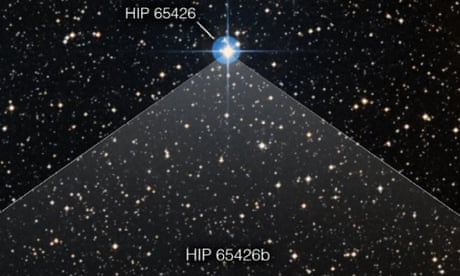A blazing gas giant shrouded in dusty red clouds has been revealed in unprecedented observations of a planet beyond our solar system. The observations, which astronomers said marked a “historic moment for astronomy”, are the first direct images of a planet beyond our solar system by Nasa’s $10bn (£8. 65bn) James Webb space telescope .
They are also the first images of an exoplanet using infrared light, which gives a far more precise indication of a planet’s mass and temperature and will allow astronomers to detect the movement of clouds drifting across the planet’s sky. “This is really a historic moment for astronomy,” said Prof Sasha Hinkley, an astronomer based at the University of Exeter, who co-led the observations. “James Webb is going to open the door to a whole new class of planets that have been completely out of reach to us and by observing them at a broad range of wavelengths we can study their compositions in a much more in-depth way.
“We will be able to detect the presence of weather. ” Directly imaging exoplanets is a huge technical challenge because the host star is so much brighter. The focus of the latest observations, HIP 65426 b, is a gas giant about five to 10 times the mass of Jupiter located 385 light-years from Earth in the Centaurus constellation.
It is about 100 times further from its host star than Earth is from the sun, making it easier to distinguish. But is still more than 10,000 times fainter than its host star – the equivalent of trying to spot a firefly next to a large lighthouse from more than 50 miles away. The latest observations put the planet’s atmospheric temperature at roughly 1,300C (2,370F) and suggest its atmosphere contains red-hued clouds of silicate dust.
“It would be a terrible place to live,” said Hinkley. “You’d be roasted alive if you could float around in the atmosphere. ” Previously, astronomers have obtained direct images of 20 or so exoplanets, including HIP 65426 b, using ground-based telescopes.
But this meant contending with noise introduced by the Earth’s atmosphere and restricted observations to a narrow range of visible wavelengths. By contrast, the latest images, captured from the cold, airless environment of space, span a wide range of wavelengths, including the infrared, which accounts for most of the light produced in the planet’s atmosphere. “The best wavelength to observe a planet is the one at which it produces the most intrinsic light because this is directly tied to the temperature of the planet,” said Dr Beth Biller, a co-principle investigator and an astronomer at the University of Edinburgh.
HIP 65426 b is only 10-20 million years old, far younger than the 4. 5bn-year-old Earth, and the latest observations give new insights into how Jupiter and Saturn may have looked in their infancy. Sign up to First Edition Free daily newsletter Archie Bland and Nimo Omer take you through the top stories and what they mean, free every weekday morning Privacy Notice: Newsletters may contain info about charities, online ads, and content funded by outside parties.
For more information see our Privacy Policy . We use Google reCaptcha to protect our website and the Google Privacy Policy and Terms of Service apply. Dr Vivien Parmentier, an associate professor in physics at the University of Oxford, who was not involved in the latest work, said: “Opening a new window into the universe always brings surprises.
Planets form big and contract with time and this baby planet seems to have shrunk faster than what we expected. This gives us amazing insights into how planets form and how our own solar system formed. ” In future, the James Webb is expected to make detailed observations of more Earth-like distant planets, including those with potentially habitable conditions .
The findings are published in a preprint posted on the Arxiv website . .
From: theguardian
URL: https://www.theguardian.com/science/2022/sep/01/historic-james-webb-images-show-exoplanet-unprecedented-detail



